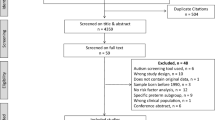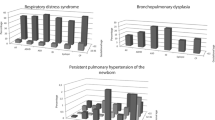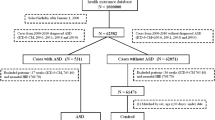Abstract
Twenty-five autistic children, constituting a total population sample of children with infantile autism, were compared with 25 sex- and maternityclinic-matched controls for occurrence of reduced optimality in the pre-, peri-, and neonatal period, as noted in medical records. Autistic children showed greatly increased scores for reduced optimality, especially with regard to prenatal factors. The findings are at odds with early reports that children with autism had not suffered potential brain injury. The reasons for the discrepancy are discussed.
Similar content being viewed by others
Reference notes
Kyllerman, M. Non-optimal pre- and perinatal conditions in dyskinetic cerebral palsy. Distribution and comparison to controls.Neuropediatrics, 1982, submitted for publication.
Kyllerman, M., & Hagberg, G. Non-optimal pre- and perinatal conditions in a Swedish newborn population.Neuropediatrics, 1982, submitted for publication.
References
Bradley, J. W.Distribution-free statistical tests, 68–86. Englewood Cliffs, New Jersey: Prentice-Hall, 1968.
Broman, S., Nichols, P., & Kennedy, W.Preschool IQ: Prenatal and developmental correlates. Hillsdale, New Jersey: Erlbaum, 1975.
Deykin, E., & MacMahon, G. Pregnancy delivery and neonatal complications among autistic children.American Journal of Diseases of Children, 1980,134, 860–864.
Finegan, J-A., & Quarrington, B. Pre-, peri- and neonatal factors and infantile autism.Journal of Child Psychology and Psychiatry, 1979,20, 119–128.
Folstein, S., & Rutter, M. Infantile autism: A genetic study of 21 twin pairs.Journal of Child Psychology and Psychiatry, 1977,18, 297–321.
Gillberg, C. Maternal age and infantile autism.Journal of Autism and Developmental Disorders, 1980,10, 293–297.
Gillberg, C. Infantile autism and other childhood psychoses in a Swedish urban region. Epidemiological aspects.Journal of Child Psychology and Psychiatry, 1983, in press.
Gillberg, C., & Rasmussen, P. Perceptual, motor and attentional deficits in seven-year-old children. Background factors.Developmental Medicine and Child Neurology, 1982,24, 752–770.
Gillberg, C., & Schaumann, H. Social class and infantile autism.Journal of Autism and Developmental Disorders, 1982,12, 223–228.
Gillberg, C., Trygstad, O., & Foss, I. Childhood psychosis and urinary excretion of peptides and protein-associated peptide complexes.Journal of Autism and Developmental Disorders, 1982,12, 229–241.
Harper, J., & Williams, S. Early environmental stress and infantile autism.Medical Journal of Australia, 1974,61, 341–346.
Kanner, L. Autistic disturbances of affective contact.Nervous Child, 1943,2, 217–250.
Knobloch, H., & Pasamanick, B. Some etiologic and prognostic factors in early infantile autism and psychosis.Pediatrics, 1975,55, 182–191.
Kolvin I., Ounsted, C., & Roth, M. Studies in the childhood psychoses—V. Cerebral dysfunction and childhood psychoses.British Journal of Psychiatry, 1971,118, 407–414.
Lobascher, M., Kingerlee, P., & Gubbay, S. Childhood autism: Aetiological factors in 25 cases.British Journal of Psychiatry, 1970,117, 525–529.
Michaelis, R., Haug, S., Majewski, F., Bierich, J. R., & Dopfer, R. Obstetrische und postnatale Komplikationen bei Kindern mit einer Alkoholembryopathie.Monatsschrift für Kinderheilkunde, 1980,128, 21–26.
Michaelis, R., Rooschüz, B., & Dopfer, R. Prenatal origin of congenital spastic hemiparesis.Early Human Development, 1980,4(3), 243–255.
Prechtl, H. F. R. Neurological findings in newborn infants after pre- and paranatal complications. In J. H. P. Jonxis, H. K. A. Visser, & J. A. Troelstra (Eds.),Aspects of prematurity and dysmaturity: A Nutrica Symposium. Leiden: Stenfert Kroesse, 1968. Pp. 306–309.
Prechtl, H. F. R. The optimality concept.Early Human Development, 1980,4(3), 201–205.
Rutter, M. Diagnosis and definition. In M. Rutter & E. Schopler (Eds.),Autism: A reappraisal of concepts and treatments. New York: Plenum Press, 1978.
Rutter, M., & Lockyer, L. A five- to fifteen-year follow-up study of infantile psychosis: I. Description of the sample.British Journal of Psychiatry, 1967,113, 1169–1182.
Rutter, M., & Schopler, E. (Eds.).Autism: A reappraisal of concepts and treatment. New York: Plenum Press, 1978.
Small, J. G. EEG and neurophysiological studies of early infantile autism.Biological Psychology, 1975,10, 385–397.
Student, M., & Sohmer, H. Evidence from auditory nerve and brainstem-evoked responses for an organic brain lesion in children with autistic traits.Journal of Autism and Childhood Schizophrenia, 1978,8, 13–20.
Torrey, E. F., Hersh, S. P., & McCabe, K. D. Early childhood psychosis and bleeding during pregnancy: A prospective study of gravid women and their offspring.Journal of Autism and Childhood Schizophrenia, 1975,5, 287–297.
Touwen, B. C. L., Huishes, H. J., Jurgens-v.d.Zee, A. D., Bierman-van Eendenburgh, M. E. C., Smrkovsky, M., & Olinga, A. A. Obstetrical condition and neonatal neurological morbidity. An analysis with the help of the optimality concept.Early Human Development, 1980,4(3), 207–228.
Wing, L.Early childhood autism (2nd ed.). Oxford: Pergamon Press, 1980.
Author information
Authors and Affiliations
Additional information
We gratefully acknowledge the assistance of Mrs. Doris Andrén in the collecting of the pertinent data, and Mrs. Gun Jakobsson for skillful secretarial assistance. This work was financially supported by a grant from the Swedish Save the Children Fund (Rädda Barnens Riksförbund).
Rights and permissions
About this article
Cite this article
Gillberg, C., Gillberg, I.C. Infantile autism: A total population study of reduced optimality in the pre-, peri-, and neonatal period. J Autism Dev Disord 13, 153–166 (1983). https://doi.org/10.1007/BF01531816
Issue Date:
DOI: https://doi.org/10.1007/BF01531816




